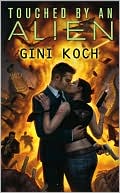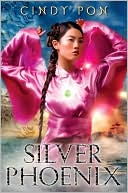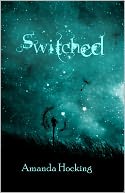First Book Friday: Gini Koch
Very imporant administrative note: Goblin Tales passed 100 sales yesterday!
Ahem. Where was I? Oh, right — First Book Friday, with Gini Koch. From Gini’s website, some of her hobbies include mooning over pictures of Steven Tyler and Joe Perry, and training her pets to ‘bring it’. I met her at World Fantasy, and… well, let’s put it this way. Her cover for Alien Tango features blue explosions, a rocketship, and an angry gator. Energetic, lively, fun, and a little random.
Gini’s a lot like that.
Her third book about “Super-Being Exterminator Kitty Katt and the Alpha Centaurian she loves,” is called Alien in the Family [Amazon | B&N | Mysterious Galaxy], and comes out on April 5.
#
I didn’t think I was cut out to be a writer because I don’t outline, and I was told by a teacher (who I knew, even at age 15, to be an idiot) that unless you outlined, you couldn’t write ANYthing. And yet, I believed her. For 20 years. And, for those years, any time I’d try to write an outline, I’d lose all the joy of the idea, bog down, and end up with nothing useful after hours of time expended.
But I always wrote in my head. I just didn’t think playing out scenes constantly was being creative — I thought it was how I passed the time while everything around me moved so slowly. I’m a multitasker of the highest order and if I don’t have something occupying at least the front and the back of my mind, said mind tends to wander into all those lovely worlds I wasn’t qualified to write.
My first novel came about because the particular voices in my head were SO loud, obnoxious and demanding, that I wrote their story down just to shut them up. I was supposed to be working (on the weekend) but looked up 8 hours later to see a lot of pages written — and a novel taking shape. I’d also discovered a joy I hadn’t known before and realized this was the thing I wanted to do, wanted to BE. I also realized that I was doing just fine without an outline.
As I wrote more and more, my technique got better. Most would have trunked that first novel, but I loved the characters too much — they were the REASON I was writing, the reason I’d discovered the thing I truly loved to do. So, I rewrote their story. In full. 9 times.
And am rewriting their story a 10th time, because while my agent loved version 9.2.2 and shopped it around, and also while we got some incredibly complimentary rejections, because it’s set in the Old West and has people on horses it’s considered a “Western”, and they don’t sell, dontchaknow. So, the characters gave me their blessing, and we’re off into a different spin. I’m excited, my agent’s excited, and the characters are excited. But I digress…
Fortunately, I didn’t know about, and then ultimately ignored, most of the writing advice out there. I’m a linear writer, I need music and chaos around me to get anything done, and I work on a variety of things at once. The idea of having to “finish one thing before you go onto the next” is alien and abhorrent to me. If I’d listened to it, I wouldn’t be published. In anything. I wrote well over a dozen novels (none published yet, some trunked, some waiting patiently for me to go back and fix them like I did my beloved First Novel) and triple that in short stories, with some novellas along the way. But I still wasn’t “there”, and I knew it.

- One of my friends was constantly nagging me to “write funny” — I finally listened to her, and the first professional sales I ever made were in short humor;
- I started playing around with different POV options, particularly going from 3rd person only to trying out 1st person;
- I finally found the crit partner I truly clicked with, and watched my writing move from really good to truly publishable;
- I realized I needed to understand pacing innately, which I didn’t at the time, and so I gave myself an assignment to write a variety of short stories in varying lengths, from micro-fiction up to 10,000 words. When I finished all of this, somehow, I indeed understood pacing and ended up with a large variety of stories to sell, many of which have indeed sold (under different pen names).
And then I had a dream — a dark, noir-ish, scary dream — and I fully intended to write a dark, noir-ish, scary story. I was still doing my short story assignments, and this looked to fit my 4,000 word slot.
By page 3, the character’s voice had taken over, by page 5 I realized this was going to be a lot longer than 4,000 words, and by the end of the first chapter that dark short story turned into a funny, sexy, science fiction novel. As I was writing it, I realized it was “the one”… the novel that would get me a great agent. It was, and said agent sent it directly off to DAW Books. The rest, as they say, is history.
Would I change anything? Yeah. If I could do it all over again, I’d ignore that teacher’s rule, like I ended up ignoring all the other rules, and start writing decades sooner. But, you know, maybe I wouldn’t have ended up with Kitty Katt and Jeff Martini and my Alien series. So, perhaps the journey’s gone exactly how it should have. As a person, that’s my view. As an author, well … there’s bound to be a story in all of that somewhere.






 Well that was an interesting 24 hours. In the first official day of being on sale, Goblin Tales sold a total of 66 copies. The breakdown between Amazon and B&N was:
Well that was an interesting 24 hours. In the first official day of being on sale, Goblin Tales sold a total of 66 copies. The breakdown between Amazon and B&N was:
 I finished the rough draft of Silver Phoenix in January 2007, then proceeded to revise the novel at least six times that year, with the help of critique group friends. At the end of January 2008, I began querying for agents. I never set out to be published. I wanted to challenge myself, but when I actually finished the novel, I loved it so much I wanted to share Ai Ling’s story with the world. I knew I had to at least try.
I finished the rough draft of Silver Phoenix in January 2007, then proceeded to revise the novel at least six times that year, with the help of critique group friends. At the end of January 2008, I began querying for agents. I never set out to be published. I wanted to challenge myself, but when I actually finished the novel, I loved it so much I wanted to share Ai Ling’s story with the world. I knew I had to at least try.